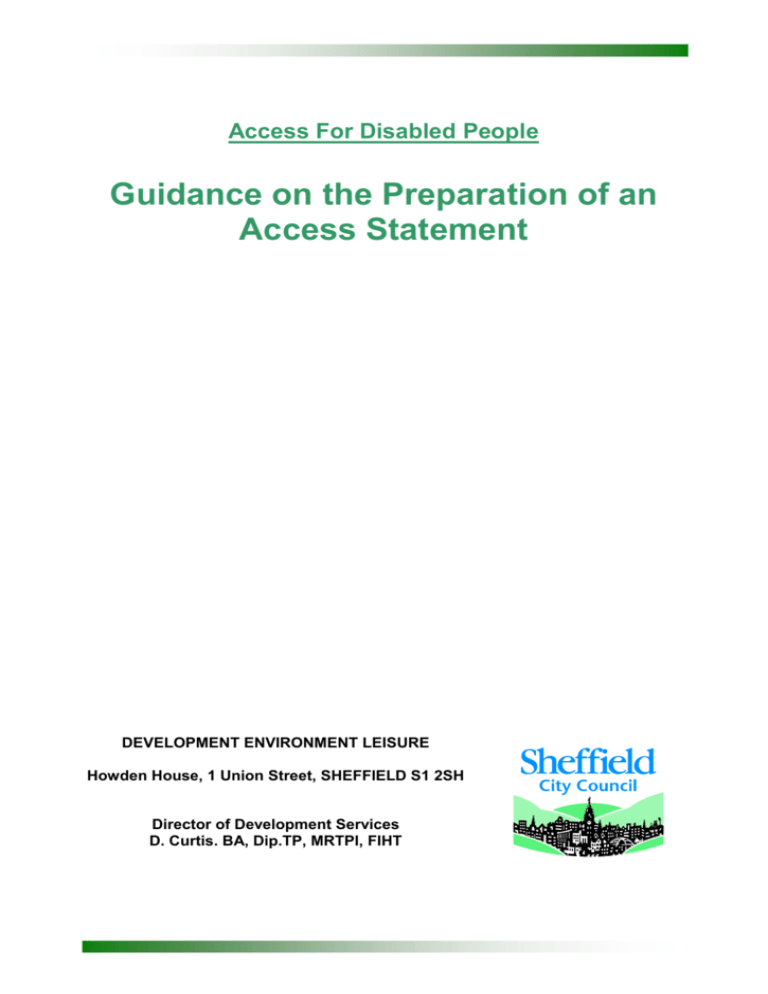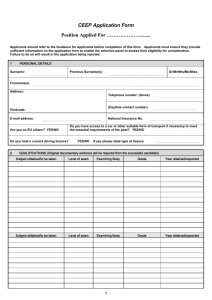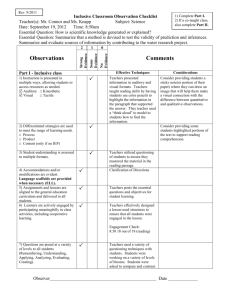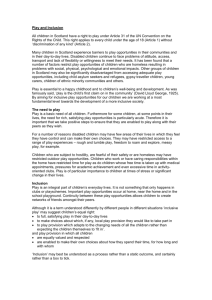Access For Disabled People
advertisement

Access For Disabled People Guidance on the Preparation of an Access Statement DEVELOPMENT ENVIRONMENT LEISURE Howden House, 1 Union Street, SHEFFIELD S1 2SH Director of Development Services D. Curtis. BA, Dip.TP, MRTPI, FIHT General Introduction In March 2003 the Office of the Deputy Prime Minister, (ODPM), issued "Planning and Access for Disabled People: A Good Practice Guide" which aims to promote a more inclusive approach to the design of the environment, focusing on disabled people and the Planning system. A key new feature is the preparation of Access Statements. The Good Practice Note states. "(The submission of a Statement) … would demonstrate the designer's commitment to take the issue of inclusive design seriously at the earliest stages." (Para 7.5.1) Access Statements also form a part of Approved Document M of the Building Regulations, paragraph 0.20 onwards. Purpose Access Statements will be required to assist with the assessment of the issues relating to disabled people, setting out how provision will be made in the proposed development. It is envisaged that it will act as a core, definitive document, providing an important degree of co-ordination for designers, regulatory staff and construction services. The circumstances in which one will be required are set out in the next section. It will form a part of the documentation for the assessment of an application in the same way any plans might. It is not an informative, general statement of intent, which applicants can choose whether or not they wish to prepare. The document will run with the development and not be solely applicable to one application. Hence, it may begin life as an explanatory statement in pre-planning application discussions and go on to be developed as Building Regulations and Licensing submissions are prepared. Where details are approved as a part of a consent or a condition, it will be necessary to carry this forward to any subsequent design work in the same way any other detail shown on a plan or in a letter will form a part of a consent. Bear in mind that if subsequent design work, eg under the Building Regulations, changes any feature approved as a part of a Planning consent, it may require the approval of the Local Planning Authority. Its written style should not focus solely on one area, e.g. Planning, at the expense of topics or issues that will impact on other legislation. This will ensure that all regulatory bodies have common information and, importantly, a common awareness of the design issues. This will ensure abortive work is avoided. It will require updating from time to time during the design and construction process, with plans substituted or written details added. A common point in time will be when new applications are submitted, such as for Building Regulation consent, when planning or licensing conditions are approved or when details become known following agreements with tenants. It is important that the Statement identifies which parts of any scheme are to be dealt with under what area of legislation. This will ensure both regulatory staff and applicants are clear what is being dealt with at which stage in the application process and what is being given consent. The next section on Format of Statement outlines this key procedural issue in detail. Overall, an Access Statement will assist with the assessment of buildings or uses in the context of compliance with the Disability Discrimination Act 1995, contributing to audit work and usability tests. Status of Statement in Determination of a Development Application Paragraph 7.5.4 of the aforementioned advice note suggests that Local Planning Authorities might reject a Planning Application and refuse to register it unless a Statement is submitted. "If an access statement is not submitted, local authorities might reject registration of an application until such time as an adequate statement is submitted. This will overcome the problem of access delaying the 8-week deadline, as applicants will have to have addressed the issues before the application is made. This will also be a great incentive for applicants to consider access from the outset." Philosophy of Statement The aim should be to adopt an inclusive approach, i.e. not to segregate people but seek to meet the needs of all potential users of an environment rather than a specific user group. But inclusive does not mean treat the same – people have different needs whilst wanting to have the same opportunities to access goods and services. The appropriate means of access should be provided for that type of building or activity. For example, automated opening equipment for doors or simply a high and low section to a bar or reception desk in order that differing needs can be met. In addition, paragraph 3.2.3 of the Good Practice Note states. "…it is not only disabled people who benefit from inclusive design. There are currently a further 18 million people who would directly or indirectly benefit from inclusive access to buildings and public spaces. These include the elderly, families with children under the age of five, carers and the friends and relatives who accompany people with disabilities. Indeed it is fair to say that all members of society would benefit to some degree from intelligent, logical and accessible design." It further goes on to say in paragraph 3.3.3. "Developments designed to be inclusive are likely to have an enhanced market value as occupiers and other purchasers of property become increasingly aware of the economic disadvantage of excluding such a substantial percentage of the population… It is significantly more cost-effective to provide for inclusive access at the design stage than to make retrospective adjustments during the construction phase or after occupation. Additional costs can be marginalised or eliminated if inclusive design is considered at an early stage. If a development is inclusively designed from the earliest concept stages, an application for planning consent is unlikely to be refused or delayed on the grounds that it does not meet appropriate access standards. This minimises the potential for delay, with obvious commercial benefits." Further information on inclusive design and the key principles is available in the Council's guidance entitled, " Accessible Environment Strategy." Format of Statement Your Statement should take the form of a written submission together with any appropriate plans. You should follow the headings given in the Appendix One Checklist that will provide guidance on what works are dealt with by which legislative areas. A model Statement is available separately for both minor and major proposals. The exact media for your submission will depend on the size and character of the application, as outlined below. An Access Statement is required for any development application falling within the following categories where the public have access, or the scheme is for residential development subject to UDP Policy H7 “Mobility Housing”. Minor proposals A Statement is required in the following four cases if an existing public access point to the building is affected, or it forms a part of the feature or works that are being applied for. Changes of use. Alterations and extensions to licensed premises, including outdoor seating areas Small scale extensions to buildings to which the public have access (See definition of public access below). Temporary uses regardless of size are not exempt if an application is required; for example, mobile offices, a retail outlet for a time limited event, etc. Small scale housing developments providing four or more dwellings. In these sorts of cases applicants may wish to make use of the application plans and simply highlight any key features with appropriate notes. They must still follow the same criteria of looking at the whole building or use and not a single application or the feature they wish to alter. This may require more detail to be shown on plans than otherwise would previously have been considered, using a clear set of identifiable notation, relating to the Access Statement. Continued overleaf... Major proposals These will require separate plans and written documentation to clearly illustrate the features relevant to the working of the scheme. Examples would include: New licensed premises or major alterations and extensions to existing licensed premises (Eg: liquor, gaming, sports grounds, public entertainment) The provision of any new housing, which will require a detailed Statement in order to show how it meets the UDP H7 "Mobility Housing", Supplementary Planning Guidance. Major commercial developments (Seed definition of public access below). Plans should explain the proposal in detail. They should include: site plan at a scale of 1:200 (or 1:500 if the size of the site dictates) floor plan(s) at a scale of 1:50 or 1:100 elevations at a scale of 1:50 or 1:100 building section(s) at a scale of 1:50 or 1:100 This is in line with the Office of the Deputy Prime Minister's 'Best Practice Guidance on the Validation of Planning Applications', where further guidance can be found. If the size of the proposed building dictates - for example a factory with a large open production area and supporting reception area, administration and staff facilities - a smaller scale may be adopted for the overall floor plan(s), elevations and section(s) and the area of the building subject to detailed consideration submitted at a scale of 1:50 or 1:100. Except for housing developments of less than four dwellings, plans of each dwelling type intended to comply with the 'Mobility Housing Supplementary Planning Guidance' accompanying UDP policy H7 should be submitted at a scale of 1:50 to indicate compliance. Information shown on the plans should include fittings, indicative furniture arrangements, door widths, door swings and wheelchair turning areas. Best Practice Guidance on the Validation of Planning Applications' defines buildings accessible to the public as including offices, shops, factories, schools and other public access areas. Content Key Issues in Scheme When an application for planning permission is made to the Local Authority, the Access Statement must describe, through the use of text and supporting plans, how disabled people will access the building or its facilities. The accompanying checklist works through the way a building would be used, highlighting the relevant questions. For example: Proximity of car parking or accessible public transport, Entrance and door design, Types of materials or Means of escape. Sources of Design Information It will be important in any Statement to show what sources of information have been used, particularly if a particular planning policy is being complied with e.g. UDP Policy H7 on accessible housing design. These are examples of some key ones. 1. Unitary Development Plan policies 2. Council’s access design information contained in: Access Environment Strategy, and the more detailed Disability Design Sheets (dDS). 3. Mobility Housing Supplementary Planning Guidance 4. Building Regulations 2004 Approved Document Part M and other relevant Approved Documents. 5. Sheffield Magistrates Policy on Licensed Premises. 6. British Standard, BS8300 on Access for Disabled People. A comprehensive set of nationally approved guidelines, available from the British Standards Institute or to view at reference section of the Central Library, Surrey Street, Sheffield. 7. The Knowledge Map Reading University have produced this important bibliography of access guidance on behalf of DPTAC It can be found on the Internet at: www.dptac.gov.uk/kmnotes.htm 8. “Inclusivew Mobility“ by the Department for Transport Where there is a deviation from a quoted standard, which may occur in works to a Listed Building, there must be a full explanation of the design solution. Disability Discrimination Act Applicants’ attention is drawn to the requirements of the Disability Discrimination Act 1995. In devising any works you are advised to ensure that your proposals for the building or site comply fully with the appropriate Codes of Practice so ensuring a complete and proper package is formulated. This will avoid the need to make any further applications for consent for subsequent alterations. APPENDIX 1: Key Features Checklist Introduction Your approach to this Statement should be to place yourself in the position of any visitor or members of staff and to run through how they will arrive at the site or building and use all its facilities. The Disability Design Standards sheet numbered dDS19 describes briefly what each area of legislation applies to. It is available separately by way of the Council’s web page www.sheffield.gov.uk (type the sheet number in the page search facility), or by telephoning 0114 2734197. The Checklist indicates in broad terms the areas of legislation refer to which group of issues. Checklist All issues are subject in some form to the Disability Discrimination Act 1995. Section 1 Travel to Site Section 4 Means of escape Subject to Planning, Highways & Building Regulations Car parking, Drop off points, Taxis. Tram and bus stops. Routes to stops. Subject to Building Regulations Design for independent means of escape. Provide facilities for physical evacuation, e.g: places of refuge, staff training, audio-visual alarm systems. Section 2 Building Environs Subject to Planning, Highways & Building Control Locations and orientation of entrances. Hard and soft landscaping. Width/Gradients to footways. Lighting. Section 5 Signs and Wayfinding Subject to Building Regulations Type and position of signs. The use of differing tactile materials. The layout of the building. Internal décor. Section 3 Building or Structures Subject to Planning & Building Regulations Materials 1. Construction – walls, doors etc. 2. Internal floor surfaces. Entrances 1. Approach. 2. Steps and ramps. 3. Door design. Subject to Building Regulations and UDP policy BE7 “Design of Buildings used by the Public”. Where proposal is a housing scheme Planning would also apply. See separate Mobility Housing guidance. Movement within building 1. Provision of lifts. 2. Stairs. 3. Corridor design – widths, changes in level 4. Reproduction of key facilities on each floor eg toilets. Key features of activity or building use 1. Receptions 2. Specialist equipment. (Fitness equipment, pool hoists) 3. Activities, eg counters in shops, dance floors in clubs, or changing areas in sports facilities. 4. Staff rooms.








